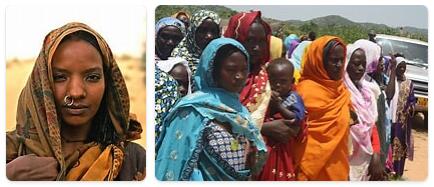
Yearbook 2004
Chad. The total population in Chad is 16,425,875 people in 2020. Chad was affected during the year by the conflict in the Darfur region of neighboring Sudan, where black Africans were chased from their villages by Arab militia. About 130,000 Darfur refugees resided on the Chadian side of the border and military activities also reached Chad.
In March, the UNHCR stated that the Sudanese militia carried out raids against the refugee camps in Chad daily, and the UNHCR was forced to move refugees further into Chad. The Chadian government deployed troops at the border.
In May there were regular battles between Chadian army soldiers and Sudanese Arab militia, who were reported to have attacked a Chadian border village. Chad claimed that 60 militiamen were killed in the fighting. The conflict led Sudanese and Chadian diplomats to meet for talks. A number of measures were agreed to prevent the violence in Darfur from reaching Chad. it was decided on joint border patrols.
In May, Chad’s parliament approved a constitutional amendment that would allow President Idriss Déby to stand for re-election, even when his second term expires in 2006. The opposition called for a nationwide strike in protest of the decision, and the call was widely followed.
During the summer, Chad was hit by huge grasshopper swarms and the country appealed for international help to combat the plague.
In December, a new peace agreement with MDJT was signed in Burkina Faso.
With the aim of President Déby being able to stand for a third term in the 2006 presidential election, in June 2005 a referendum was held to amend the constitution. The change was adopted by 66% of the vote. In November, former President Habré was arrested in Senegal, charged with crimes against humanity. Insurgent forces attacked the city of Adre near the border with Sudan in December 2005. N’Djamena accused Khartoum of being behind the attack.
In January 2006, President Déby supported a bill that reduced the investment rate from oil export revenues. In response, the World Bank suspended its loans to the country and frozen the government’s accounts. In March, authorities said they had averted a military coup attempt. In a new coup attempt in April, insurgent troops fought against government troops outside the capital. Chad now severed diplomatic relations with Sudan, which it accused of being behind the coup attempts.
Despite the tense security situation, in May presidential elections were held. It was boycotted by the opposition. Not surprisingly, Déby therefore won the election with 64.7% of the vote.
Sudan and Chad signed an agreement in May 2007 to establish a security zone under UN control in Darfur (see Sudan). The proposal had been tabled by Saudi Arabia and anticipated the deployment of international observers. The UN warned that the conflict could spread from Darfur into Chad.
In July 2007, Debby’s son, Brahim, was found dead in a Paris parking garage. He had apparently died of powder from a powder extinguisher and the French police launched a murder investigation. Brahim had been fired as a government adviser the year before because he had been in possession of drugs and weapons. Insurgent leader Makaila Nguebla stated that Brahim was the primary reason why ministers had withdrawn from their posts. Even senior ministers had been beaten and humiliated by the president’s son.
Nevertheless, the conflict in Darfur spread into Chad and reached the capital N’Djamena in February 2008, where battles lasted for several days. Over the course of a few days, the rebels were defeated by government troops, and Déby declared at a press conference Feb. 6 that there were mercenaries ruled by Sudan. He further stated that Chad’s army had control over the country. In 2008, Chad had received 280,000 refugees from Darfur, 55,000 from the Central African Republic and had 170,000 internally displaced people.

HUMAN AND ECONOMIC GEOGRAPHY
Internal state of north-central Africa. At the 1993 census the population was equal to 6,279,931 residents, Which became, according to some estimates, 9,749,000 in 2005, thanks to a high annual growth coefficient (3.4 ‰ on average in the period 2000-2005). This demographic load weighs heavily on the scarce internal resources, and the social conditions of the population are still little more than primitive: in 2005 life expectancy at birth was just 45 years for men and 49 for women, and infant mortality of the 93.8 ‰; in 2002 only 27 % of the population had access to safe water and 29 % to health services. The only large urban agglomeration remained that of the capital, N’djamena, which in 2003 had about 796,800 residents. More than 100,000 refugees from the Sudanese region of Dārfūr have taken refuge in the eastern part of the country, increasing tension in an area where anti-government guerrilla groups are present.
In the early 21st century. the activity of the agricultural sector was still sustained, even if one of the traditional commercial crops, that of cotton, appeared to be in slow decline: the income derived from it, which in 2001 represented 41 % of total exports, fell in 2003 to 16 %. In 2004 the sector underwent some structural reforms, in an attempt to facilitate relations between producers and potential foreign investors, but remains in crisis, mainly due to the decline in cotton prices on world markets, and the privatization of the largest agricultural company. state appears compromised. In 2002 the country’s economy showed a marked increase, as a consequence of the exploitation of new oil wells in the Doba basin. The following year also began the exploitation of the Komé field (300 wells), and a refinery was inaugurated near N’djamena and an oil pipeline to transport oil to the port of Kribi (in Cameroon).